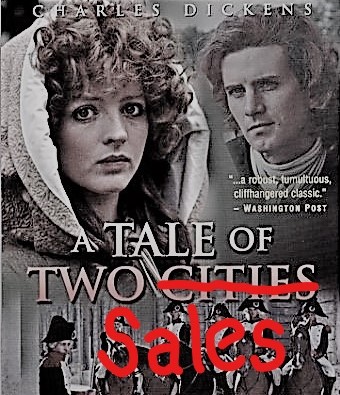“It was the best of times; it was the worst of times.”
Two wonderful business-owner friends recently completed the sale of their companies. These successful endings had different inspirations and paths. I’m sharing them hoping they instill confidence that, even with drama, great endings happen.
I wrote my book, Exit Signs: The Express Way to Leaving Your Business with Pride and Profit, to help owners produce a sale that would realize three goals: 1) a rewarding payout 2) sustainability after the sale and 3) taking care of one’s people. I said it was a several-year production often filled with predictable drama. My friends’ exits took between 2 and 3 years. I asked them to share their experiences and insights.
Two Owners’ Reflections
Deciding to Sell Isn’t Easy
My Boomer buddy (Mr. B) had owned his medical practice for 42 years. He had a great practice and stellar reputation. And he was clear he wanted to retire. The questions he faced were how soon, to whom, and how to ensure his staff and patients would continue to be well cared for. Of course, he hoped to get a good return on his 42-year investment in the practice. Besides his strong book of business, he owned his office building.
My Gen X entrepreneurial friend (Ms. X) had owned her business for nearly 13 years, building it into a nationally recognized, boutique marketing consulting firm with gross revenues of eight million dollars. Not bad for a single-owner, four-person dispersed organization working from homes. Her motivation for selling was a cross-roads question: whether to invest in growth, “stay the course” or sell.
Both owners wanted a liquidation event. Both were concerned about finding the right buyer who would respect and continue the reputation they had built and take care of their people and clients. However, Ms. X, if she sold, also wanted to continue to do what she loved by working for the acquiring company.
Recalling the Early Process
Mr. B began his exit planning with the premise that his practice had economic value to a buyer. His first two potential buyers seemed to feel otherwise and wanted multiple concessions that led to endless negotiations. He also believed his fellow professionals to be like him — people who could be trusted, with integrity and goodwill — until a potential buyer walked off with his client list and tried to woo Mr. B’s patients away. It was a hard lesson on the importance of confidentiality agreements. These dramas were intense and stressful, and Mr. B found himself doubting his intuition about buyers. At one point, Mr. B was ready to simply shutter his practice.
Ms. X told me, “Acquisition was never my exit plan.” She had been led to believe that goodwill was a fantasy for professional services companies like hers. Then a bluebird buyer appeared. A bluebird flies in your window singing lovely songs that flatter and seduce. Thanks to her own excellent due-diligence with the CEO and his people, she learned his strategy was to buy and flip. The deal terms also set off alarm bells – she felt the risks were all hers. She followed her gut and said, “No thanks.”
Reflections on the Later Phase
Ms. X learned in this early phase that, in fact, “the business I built did have value to a buyer.” And she learned that while she could always stay the course, an acquisition was, in fact, what she wanted as her exit strategy. So, she began her seller due-diligence to identify a desired buyer profile. She worked in a tight-knit industry where everyone knows the players – warts and all. She made a list of possible buyers. One-by-one she evaluated them on her five criteria for fit:
- a compatible culture and values about people that would not only protect her team but provide them with career growth opportunities;
- a stellar reputation with clients;
- an entrepreneurial spirit that would be open to new ideas and allow her to broaden her role;
- a shared conviction in the importance of preserving the reputation of Ms. X’s company;
- people she wanted to be around every day!
It became clear who her first choice was. She made her pitch to the company president at an industry conference. He quickly said yes to the intent and direction of an acquisition! Then came the scary part — not negotiating the terms, but how to plan and when to inform her team and her clients. She didn’t want to lose these valued assets. So, she pulled out her copy of Exit Signs to the chapter on anticipating and planning for talent retention and went to work creating her approach and messages.
By the time the deal closed, the vision for the acquisition was clear to all, stay bonuses and career options were communicated, and counterpart relationships had begun forming, resulting in the team being committed to the new company.
Mr. B began his exit journey believing he had 3 priorities in his exit — in this order:
- leave a legacy in his business – it would continue to serve his patients well;
- his staff would be cared for;
- a sound return on his practice would provide for his family’s future.
He struggled on, working with a competent broker eventually deciding to lower the price. In the ensuing months he also had an epiphany about his priorities. So, when an experienced professional, wanting to move in-state, appeared with a dual interest of buying the practice and the building, Mr. B had a confident mindset.
Using his strong relationship skills and intuition about people, Mr. B learned that while the prospective buyer had a different business and medical model, his values and priorities were similar. Together they created a transition period to help staff and clients learn about the new owners and let Mr. B say goodbye. The deal closed within a six months.
The Emotional Reveal
How different these paths and their dramas were. The experiences also had different emotional endings.
For Ms. X there is relief and excitement. She is enthusiastic about the future – for herself and her people. For a mid-career owner looking for the next meaningful challenge, this outcome could not have been more perfect, despite the disappointing (but educational) early phase.
For Mr. B there is relief but no elation. He told me, “I’m feeling beat up, and it will take some healing time.” Those in health care aren’t the ‘hardened’ business types at ease with the drama of sales processes and negotiations. And, quite normally, a late-stage career Boomer feels a loss and melancholy about what he leaves behind, no matter how longed-for the change was.
The Big AHA!
When asked what their biggest insight was from these “best of times and worst of times,” they had a surprising similar Aha.
Mr. B said, “Get clear on your priorities and values; make yourself take a hard look at them.” In the middle of his selling journey he had taken a ‘test’ from my book that forced him to evaluate his priorities. What he learned was “Taking Care of Your Family Financially” was in fact number 1 not number 3. Patients and staff would likely take care of their needs in a town with many options. This wasn’t abandoning his altruism, but realizing at his age, he needed to place more emphasis on his and his family’s goals. And so, he exited with a decent cash out – and his key employee was, in fact, retained.
Ms. X said, “Stay true to your core values and goals.” As an owner who wanted to integrate into the new company vs. retire or become an independent consultant, she was clear that culture-fit and protecting her team were more important than ROI. (And she got her price too!)
I hope this Tale of Two Sales helps you think about your own exit strategy. For more about how to direct your own company sale with minimized drama, I invite you to read, Exit Signs: The Express Way to Leaving Your Business with Pride and Profit.
How Will You Write a Successful Tale for the
Sale of Your Business?

